Massive Dolomitization of Interior and Slope to Basin-Margin Facies of the Triassic Yangtze Platform Through Superposed Earth-Surface and Burial Mechanisms, Nanpanjiang Basin, South China
Abstract
1. Introduction
2. Geologic Setting
3. Materials and Methods
3.1. Field Work
3.2. Petrographic Methods
3.3. Burial History
3.4. Fluid-Inclusion Microthermometry
3.5. Geochemistry
4. Results
4.1. Dolomite Distribution and Field Observations of Dolomitized Facies
4.2. Petrography
4.2.1. Precursor Limestone Facies
- Interior pervasively dolomitized massive thick-bedded to massive intervals, which are inferred to have originally been mudstone to wackestone. Locally, this facies contains fabric observable in outcrop including burrows, oncoids, and skeletal fragments (Figure 3d).
- Interior stratiform carbonate breccia intervals that are pervasively dolomitized and interpreted to be evaporite solution collapse breccia (Figure 3d,e). The stratiform breccia contains angular clasts, often displays concave–convex contacts between clasts, and contains molds of evaporite nodules (Figure 3a,e).
- Platform margin Tubiphytes boundstone that is tightly occluded by bladed marine cement and locally contains minor dolomitized micritic elements (Tubiphytes and grains) at the transition from the reef facies to the foreslope (Figure 5a).
- Slope debris-flow breccia pervasively dolomitized at the basin margin and partially dolomitized in the upper slope and proximal foreslope facies (Figure 4a–c).
4.2.2. Dolomite Types and Paragenetic Sequence
- Anhedral very fine to finely crystalline (0.01–0.06 mm) non-planar crystals that replace micrite, calcareous grains, and vadose cements in the microbial caps of peritidal cycles in the platform interior (Figure 5b) as well as a complete replacement of pelagic lime mudstone facies in the basin margin and slope (Figure 5c and Figure 6a).
- Anhedral to subhedral, medium to coarsely crystalline (0.06–0.5 mm) non-planar to planar-s fabric-destructive dolomite that completely replaced massive thick beds and evaporite solution collapse breccia beds in the platform interior (Figure 3d,e) and fabric retentive dolomite that partially or completely replaces packstone–grainstone carbonate turbidite beds in the slope and basin margin (Figure 5d). This dolomite contains cloudy cores with abundant inclusions.
- Coarse euhedral replacement dolomite (0.3–0.8 mm) that occurs sporadically in massive replacement dolomite (described above) and locally has euhedral crystal surfaces facing extant intergranular or vuggy porosity. This dolomite contains cloudy cores with abundant fluid inclusions and outer zones highlighted by variation in inclusion density.
- Coarse euhedral dolomite cement (0.3–0.8 mm) lining extant fenestral or intergranular porosity in platform interior facies and in slope grainstone beds (e.g., Figure 5b).
- Saddle dolomite and euhedral zoned dolomite cement crystals up to 1 mm infilling voids between clasts in platform interior breccia and late-stage vugs or fractures in slope and basin-margin facies (Figure 6b–e).
4.3. Constraints on Burial History and Temperatures
4.4. Fluid-Inclusion Microthermometry
4.5. Oxygen, Carbon, and Strontium Isotopes
4.6. Minor and Trace Elements
4.7. U-Pb Age Dates Using LA-ICP-MS
5. Discussion
5.1. Modes and Relative Timing of Dolomitization from Field Relationships
5.2. Paragenesis of Dolomite and Other Diagenetic Phases
5.3. Burial and Thermal History
5.4. Temperature and Salinity of Dolomitizing Fluids from Fluid-Inclusion Analysis
5.5. Geochemical Constraints on Origin of Dolomitizing Fluids
5.6. Absolute Age Constraints on Dolomitization and Calcite Diagenesis
5.7. Dolomitization Model and Implications
6. Conclusions
Author Contributions
Funding
Data Availability Statement
Acknowledgments
Conflicts of Interest
Abbreviations
| km | kilometers |
| m | meters |
| mm | millimeters |
| µm | micrometers |
| µg | microgram |
| FIA | Fluid inclusion assemblage |
| Th | homogenization temperature |
| Tmice | freezing point depression |
| Tn | ice nucleation temperatures |
| TIMS | Thermal Ionization Mass Spectrometry |
| FIRST | Facility for isotope research and student training |
References
- Hardie, L.A. Perspectives on dolomitization: A critical review of some current views. J. Sediment. Petrol. 1987, 57, 166–183. [Google Scholar] [CrossRef]
- Warren, J. Dolomite: Occurrence. evolution and economically important associations. Earth-Sci. Rev. 2000, 52, 1–81. [Google Scholar] [CrossRef]
- Machel, H. Concepts and models of dolomitization: A critical reappraisal. Geol. Soc. Lond. Spec. Publ. 2004, 235, 7–63. [Google Scholar] [CrossRef]
- Manche, C.J.; Kaczmarek, S.E. A global study of dolomite stoichiometry and cation ordering through the Phanerozoic. J. Sediment. Res. 2021, 91, 520–546. [Google Scholar] [CrossRef]
- Arvidson, R.S.; Mackenzie, F.T. The dolomite problem. control of precipitation kinetics by temperature and saturation state. Am. J. Sci. 1999, 299, 257–288. [Google Scholar] [CrossRef]
- Gregg, J.M.; Bish, D.L.; Kaczmarek, S.E.; Machel, H.G. Mineralogy, nucleation and growth of dolomite in the laboratory and sedimentary environment. A review. Sedimentol 2015, 62, 1749–1769. [Google Scholar] [CrossRef]
- Morrow, D. Regional Subsurface Dolomitization: Models and Constraints. Geosci. Can. 1998, 25, 57–70. [Google Scholar]
- Manche, C.J.; Kaczmarek, S.E. Evaluating reflux dolomitization using a novel high-resolution record of dolomite stoichiometry: A case study from the Cretaceous of central Texas, USA. Geology 2019, 47, 586–590. [Google Scholar] [CrossRef]
- Ryan, B.H.; Kaczmarek, S.E.; Rivers, J.M. Early and pervasive dolomitization by near-normal marine fluids: New lessons from an Eocene evaporative setting in Qatar. Sedimentology 2020, 67, 2917–2944. [Google Scholar] [CrossRef]
- Friedman, G.M. Structurally controlled hydrothermal dolomite reservoir facies: An overview: Discussion. AAPG Bull. 2007, 91, 1339–1341. [Google Scholar] [CrossRef]
- Luczaj, J.A. Evidence against the Dorag (mixing-zone) model for dolomitization along the Wisconsin arch A case for hydrothermal diagenesis. AAPG Bull. 2006, 90, 1719–1738. [Google Scholar] [CrossRef]
- Luczaj, J.A.; Harrison, W.B., III; Williams, N.S. Fractured hydrothermal dolomite reservoirs in the Devonian Dundee Formation of the central Michigan Basin. AAPG Bull. 2006, 90, 1787–1801. [Google Scholar] [CrossRef]
- Smith, L.B. Origin and reservoir characteristics of Upper Ordovician Trenton–Black River hydrothermal dolomite reservoirs in New York. AAPG Bull. 2006, 90, 1691–1718. [Google Scholar] [CrossRef]
- Conliffe, J.; Azmy, K.; Greene, M. Hydrothermal dolomites in the lower Ordovician Catoche Formation: Implications for hydrocarbon exploration in western Newfoundland. Mar. Pet. Geol. 2012, 30, 161–173. [Google Scholar] [CrossRef]
- Martín-Martín, J.D.; Travé, A.; Gomez-Rivas, E.; Salas, R.; Sizun, J.P.; Vergés, J.; Corbella, M.; Stafford, S.L.; Alfonso, P. Fault-controlled and stratabound dolostones in the Late Aptian–earliest Albian Benassal Formation (Maestrat Basin, E Spain): Petrology and geochemistry constrains. Mar. Pet. Geol. 2015, 65, 83–102. [Google Scholar] [CrossRef]
- Stacey, J.; Corlett, H.; Holland, G.; Koeshidayatullah, A.; Cao, C.; Swart, P.; Crowley, S.; Hollis, C. Regional fault-controlled shallow dolomitization of the Middle Cambrian Cathedral Formation by hydrothermal fluids fluxed through a basal clastic aquifer. GSA Bull. 2021, 133, 2355–2377. [Google Scholar] [CrossRef]
- Mansurbeg, H.; Alsuwaidi, M.; Morad, D.; Morad, S.; Tiepolo, M.; Shahrokhi, S.; Al-Aasm, I.S.; Koyi, H. Disconformity-controlled hydrothermal dolomitization and cementation during basin evolution. Upper Triassic carbonates 2024, UAE. Geology 2024, 52, 486–491. [Google Scholar] [CrossRef]
- Benjakul, R.; Hollis, C.; Robertson, H.; Sonnenthal, E.; Whitaker, F. Understanding controls on hydrothermal dolomitisation. insights from 3D Reactive Transport Modelling of geothermal convection. Solid Earth 2020, 11, 2439–2461. [Google Scholar] [CrossRef]
- Koeshidayatullah, A.; Corlett, H.; Stacey, J.; Swart, P.K.; Boyce, A.; Robertson, H.; Whitaker, F.; Hollis, C. Evaluating new fault-controlled hydrothermal dolomitization models: Insights from the Cambrian Dolomite, Western Canadian Sedimentary Basin. Sedimentology 2020, 67, 2945–2973. [Google Scholar] [CrossRef]
- Land, L.S. The isotopic and trace element geochemistry of dolomite: The state of the art. In Concepts and Models of Dolomitization; Zenger, D.H., Dunham, J.B., Ethington, R.L., Eds.; SEPM Special Publication: Claremore, OK, USA, 1980; Volume 28, pp. 87–110. [Google Scholar] [CrossRef]
- Machel, H.G.; Mountjoy, E.W. General constraints on extensive pervasive dolomitization–and their application to the Devonian carbonates of Western Canada. Bull. Can. Petrol. Geol. 1987, 35, 143–158. [Google Scholar]
- Nader, F.H.; Swennen, R.; Ellam, R. Reflux stratabound dolostone and hydrothermal volcanism-associated dolostone: A two-state dolomitization model (Jurassic, Lebanon). Sedimentology 2004, 51, 339–360. [Google Scholar] [CrossRef]
- Wang, G.; Li, P.; Hao, F.; Zou, H.; Yu, X. Origin of dolomite in the third member of Feixianguan Formation (Lower Triassic) in the Jiannan area, Sichuan Basin, China. Mar. Pet. Geol. 2015, 63, 127–141. [Google Scholar] [CrossRef]
- Niu, J.; Huang, W.-H.; Liang, F. Geochemical characteristics and genesis of Lower Ordovician dolomite in the southwest Tarim Basin, Northwest China. Episodes 2019, 42, 33–54. [Google Scholar] [CrossRef]
- Pan, L.; Shen, A.; Zhao, J.-X.; Hu, A.; Hao, Y.; Liang, F.; Feng, Y.; Wang, X.; Jiang, L. LA-ICP-MS U-Pb geochronology and clumped isotope constraints on the formation and evolution of an ancient dolomite reservoir: The Middle Permian of Northwest Sichuan Basin (SW China). Sediment. Geol. 2020, 407, 105728. [Google Scholar] [CrossRef]
- Li, P.; Zou, H.; Yu, X.; Hao, F.; Wang, G. Source of dolomitizing fluids and dolomitization model of the upper Permian Changxing and Lower Triassic Feixianguan formations, NE Sichuan Basin, China. Mar. Pet. Geol. 2021, 125, 104834. [Google Scholar] [CrossRef]
- Li, X.; Lehrmann, D.J.; Luczaj, J.; Kelley, B.M.; Cantrell, D.L.; Yu, M.; Ferrill, N.L.; Payne, J.L. Unraveling two formation mechanisms of massive dolostone in the Lower Triassic sequence of an isolated carbonate platform in Nanpanjiang Basin, south China. Sediment. Geol. 2022, 440, 106240. [Google Scholar] [CrossRef]
- Liu, D.; Cai, C.; Hu, Y.; Peng, Y.; Jiang, L. Multistage dolomitization and formation of ultra-deep Lower Cambrian Longwangmiao Formation reservoir in central Sichuan Basin, China. Mar. Pet. Geol. 2021, 123, 104752. [Google Scholar] [CrossRef]
- Shen, A.; Luo, X.; Hu, A.; Qiao, Z.; Zhang, Z. Dolomitization evolution and its effects on hydrocarbon reservoir formation from penecontemporaneous to deep burial environment. Pet. Explor. Dev. 2022, 49, 731–743. [Google Scholar] [CrossRef]
- Prather, B.E.; Goldstein, R.H.; Kopaska-Merkel, D.C.; Heydari, E.; Gill, K.; Minzoni, M. Dolomitization of reservoir rocks in the Smackover Formation, southeastern Gulf Coast, USA. Earth-Sci. Rev. 2023, 244, 104512. [Google Scholar] [CrossRef]
- Ryan, B.H.; Petersen, S.V.; Rivers, J.M.; Kaczmarek, S.E. Clumped-isotope evidence for the formation of nonplanar dolomite textures at near-surface temperatures. J. Sediment. Res. 2023, 93, 729–740. [Google Scholar] [CrossRef]
- Yang, Z.; Sun, H.; Zhong, D.; Zhang, B.; Liu, R.; Zeng, Y.; Chen, X.; Li, R.; Peng, S. Effects of basin tectonic evolution on multi-phase dolomitization: Insights from the Middle Permian Qixia Formation of the NW Sichuan Basin, SW China. Sediment. Geol. 2024, 470, 106718. [Google Scholar] [CrossRef]
- Enos, P.; Lehrmann, D.J.; Wei, J.; Yu, Y.; Xiao, J.; Chaikin, D.H.; Minzoni, M.; Berry, A.K.; Montgomery, P. Montgomery Triassic Evolution of the Yangtze Platform in Guizhou Province, People’s Republic of China; Special Paper 417; Geological Society of America: Boulder, CO, USA, 2006; p. 105. [Google Scholar] [CrossRef]
- Lehrmann, D.J.; Donghong, P.; Enos, P.; Minzoni, M.; Ellwood, B.B.; Orchard, M.J.; Jiyan, Z.; Jiayong, W.; Dillett, P.; Koenig, J.; et al. Impact of differential tectonic subsidence on isolated carbonate platform evolution: Triassic of the Nanpanjiang basin, south China. AAPG Bull. 2007, 91, 287–320. [Google Scholar] [CrossRef]
- Minzoni, M.; Lehrmann, D.J.; Payne, J.; Enos, P.; Yu, M.; Wei, J.; Kelley, B.; Li, X.; Schaal, E.; Meyer, K.; et al. Triassic Tank. Platform margin and slope architecture in space and time, Nanpanjiang Basin, south China. In Deposits, Architecture and Controls of Carbonate Margin, Slope, and Basinal Settings; Playton, T., Harris, P.M., Verwer, K., Eds.; SEPM (Society for Sedimentary Geology): Claremore, OK, USA, 2014; Volume 105, pp. 84–113. [Google Scholar] [CrossRef]
- Minzoni, M.; Lehrmann, D.J.; Dezoeten, E.; Enos, P.; Montgomery, P.; Berry, A.; Qin, Y.; Meiyi, Y.; Ellwood, B.; Payne, J.L. Drowning of the Triassic Yangtze Platform, south China by tectonic subsidence into toxic deep waters of an anoxic basin. J. Sediment. Res. 2015, 85, 419–444. [Google Scholar] [CrossRef]
- Lehrmann, D.J.; Stepchinski, L.M.; Wolf, H.E.; Li, L.; Li, X.; Minzoni, M.; Yu, M.; Payne, J.L. The Role of carbonate factories and seawater chemistry on basin-wide ramp to high-relief carbonate platform evolution: Triassic, Nanpanjiang Basin, South China. Depos. Rec. 2022, 8, 386–418. [Google Scholar] [CrossRef]
- Enkin, R.J.; Yang, Z.; Chen, Y.; Courtillot, V. Paleomagnetic constraints on the geodynamic history of the major blocks of China from the Permian to the present. J. Geophys. Res. 1992, 97, 13953–13989. [Google Scholar] [CrossRef]
- Van der Voo, R. Paleomagnetism of the Atlantic, Tethys and Iapetus Oceans; Cambridge University Press: Cambridge, UK, 1993; 411p. [Google Scholar] [CrossRef]
- Meng, Q.; Zhang, G. Timing of collision of the north and south China blocks. controversy and reconciliation. Geology 1999, 27, 123–126. [Google Scholar] [CrossRef]
- Jan, G.; Krobicki, M.; Pająk, J.; Van Giang, N. Global Plate Tectonics and Paleogeography of Southeast Asia; Faculty of Geology, Geophysics and Environmental Protection, Akademia Górniczo-Hutnicza University of Science and Technology: Arkadia, Greece, 2006; pp. 1–128. ISBN 83-88927-10-8. [Google Scholar]
- Carter, A.; Roques, D.; Bristow, C.; Kinny, P. Understanding Mesozoic accretion in southeast Asia. significance of Triassic thermotectonism (Indosinian orogeny) in Vietnam. Geology 2001, 29, 211–214. [Google Scholar] [CrossRef]
- Cai, J.-X.; Zhang, K.-J. A new model for the Indochina and south China collision during the later Permian to the Middle Triassic. Tectonophysics 2009, 467, 35–43. [Google Scholar] [CrossRef]
- Kelley, B.M.; Lehrmann, D.J.; Yu, M.; Jost, A.B.; Meyer, K.M.; Lau, K.V.; Altiner, D.; Li, X.; Minzoni, M.; Schaal, E.K.; et al. Controls on carbonate platform architecture across the Paleozoic-Mesozoic transition: A high-resolution analysis of the Great Bank of Guizhou. Sedimentology 2020, 67, 3119–3151. [Google Scholar] [CrossRef]
- Lehrmann, D.J.; Payne, J.L.; Paul, E.; Montgomery, P.; Wei, J.; Yu, Y.; Xiao, J.; Orchard, M.J. Excursion Guide. Permian-Triassic boundary and a Lower-Middle Triassic boundary sequence on the Great Bank of Guizhou, Nanpanjiang basin, southern Guizhou Province. Albertiana 2005, 33, 167–184. [Google Scholar]
- Xie, J.; Wang, K.; Han, D. (Eds.) Regional Geology of Guizhou Province; People’s Republic of China Ministry of Geology and Mineral Resources, Geological Memoirs; Dizi Publishing House: Beijing, China, 1987. (In Chinese) [Google Scholar]
- Sibley, D.F.; Gregg, J.M. Classification of dolomite rock textures. J. Sediment. Petrol. 1987, 57, 967–975. [Google Scholar] [CrossRef]
- Sun, Y.; Joachimski, M.M.; Wignall, P.B.; Yan, C.; Chen, Y.; Jiang, H.; Wang, L.; Lai, X. Lethally hot temperatures during the Early Triassic greenhouse. Science 2012, 338, 366–370. [Google Scholar] [CrossRef] [PubMed]
- Judd, E.J.; Tierney, J.E.; Lunt, D.J.; Montañez, I.P.; Huber, B.T.; Wing, S.L.; Valdes, P.J. A 485-million-year history of Earth’s surface temperature. Science 2024, 385, eadk3705. [Google Scholar] [CrossRef]
- Epstein, A.G.; Epstein, J.B.; Harris, L.D. Conodont color alteration—An index to organic metamorphism. USGS Prof. Pap. 1977, 995, 27. [Google Scholar]
- Goldstein, R.H. Fluid inclusions in sedimentary and diagenetic systems. Lithos 2001, 55, 159–193. [Google Scholar] [CrossRef]
- Goldstein, R.H. Fluid-inclusion geothermometry in sedimentary systems. from paleoclimate to hydrothermal. In Analyzing the Thermal History of Sedimentary Basins: Methods and Case Studies; SEPM (Society for Sedimentary Geology): Claremore, OK, USA, 2012; Volume 103, pp. 45–63. [Google Scholar] [CrossRef]
- Bodnar, R.J. Revised equation and table for determining the freezing point depressions of H2O-NaCl solutions. Geochem. Et Cosmochim. Acta 1993, 57, 683–684. [Google Scholar] [CrossRef]
- Wilkinson, J.W. Metastable freezing a new method for the estimation of salinity in aqueous fluid inclusions. Econ. Geol. 2017, 112, 185–193. [Google Scholar] [CrossRef]
- McArthur, J.M.; Howarth, R.J.; Bailey, T.R. Strontium Isotope Stratigraphy. LOWESS Version 3: Best Fit to the Marine Sr-Isotope Curve for 0–509 Ma and Accompanying Look-up Table for Deriving Numerical Age. J. Geol. 2001, 109, 155–170. [Google Scholar] [CrossRef]
- Roberts, N.M.W.; Rasbury, E.T.; Parrish, R.R.; Smith, C.J.; Horstwood, M.S.A.; Condon, D.J. A calcite reference material for LA-ICP-MS U-Pb geochronology. Geochem. Geophys. Geosystems 2017, 18, 2807–2814. [Google Scholar] [CrossRef]
- Rasbury, E.T.; Present, T.M.; Northrup, P.; Tappero, R.V.; Lanzirotti, A.; Cole, J.M.; Wooton, K.M.; Hatton, K. Tools for uranium characterization in carbonate samples. case studies of natural U–Pb geochronology reference materials. Geochronology 2021, 3, 103–122. [Google Scholar] [CrossRef]
- Paton, C.; Hellstrom, J.; Paul, B.; Woodhead, J.; Hergt, J. Iolite, Freeware for the visualisation and processing of mass spectrometric data. J. Anal. At. Spectrom. 2011, 26, 2508. [Google Scholar] [CrossRef]
- Longerich, H.P.; Jackson, S.E.; Günther, D. Inter-laboratory note. Laser ablation inductively coupled plasma mass spectrometric transient signal data acquisition and analyte concentration calculation. J. Anal. At. Spectrom. 1996, 11, 899–904. [Google Scholar] [CrossRef]
- Drost, K.; Chew, D.; Petrus, J.A.; Scholze, F.; Woodhead, J.D.; Schneider, J.W.; Harper, D.A.T. An ImageMapping Approach to U-Pb LA-ICP-MS Carbonate Dating and Applications to Direct Dating of Carbonate Sedimentation. Geochem. Geophys. Geosystems 2018, 19, 4631–4648. [Google Scholar] [CrossRef]
- Vermeesch, P.; IsoplotR. A free and open toolbox for geochronology. Geosci. Front. 2018, 9, 1479–1493. [Google Scholar] [CrossRef]
- Nuriel, P.; Wotzlaw, J.-F.; Ovtcharova, M.; Vaks, A.; Stremtan, C.; Šala, M.; Roberts, N.M.W.; Kylander-Clark, A.R.C. The use of ASH-15 flowstone as a matrix-matched reference material for laser-ablation U−Pb geochronology of calcite. Geochronology 2021, 3, 35–47. [Google Scholar] [CrossRef]
- Guillong, M.; Wotzlaw, J.F.; Looser, N.; Laurent, O. Evaluating the reliability of U–Pb laser ablation inductively coupled plasma mass spectrometry (LA-ICP-MS) carbonate geochronology: Matrix issues and a potential calcite validation reference material. Geochronology 2020, 2, 155–167. [Google Scholar] [CrossRef]
- Ferrill, D.A.; Morris, A.P.; Evans, M.A.; Burkhard, M.; Groshong, R.H.; Onasch, C.M. Calcite twin morphology: A low-temperature deformation geothermometer. J. Struct. Geol. 2004, 26, 1521–1529. [Google Scholar] [CrossRef]
- Payne, J.L.; Lehrmann, D.J.; Wei, J.; Orchard, M.J.; Schrag, D.P.; Knoll, A.H. Large perturbations of the carbon cycle during recovery from the End-Permian extinction. Science 2004, 305, 506–509. [Google Scholar] [CrossRef]
- Song, H.; Wignall, P.B.; Tong, J.; Song, H.; Chen, J.; Chu, D.; Tian, L.; Luo, M.; Zong, K.; Chen, Y.; et al. Integrated Sr isotope variations and global environ-mental changes through the Late Permian to early Late Triassic. Earth Planet. Sci. Lett. 2015, 424, 140–147. [Google Scholar] [CrossRef]
- Meister, P.; Mckenzie, J.A.; Bernasconi, S.M.; Brack, P. Dolomite formation in the shallow seas of the Alpine Triassic. Sedimentol 2013, 60, 270–291. [Google Scholar] [CrossRef]
- Sena, C.M.; Cedric, M.J.; Jourdan, A.L.; Vandeginste, V.; Manning, C. Dolomitization of Lower Cretaceous Peritidal Carbonates By Modified Seawater: Constraints From Clumped Isotopic Paleothermometry, Elemental Chemistry, and Strontium Isotopes. J. Sediment. Res. 2014, 84, 552–566. [Google Scholar] [CrossRef]
- Diloreto, Z.A.; Garg, S.; Bontognali, T.R.R.; Dittrich, M. Modern dolomite formation caused by seasonal cycling of oxygenic phototrophs and anoxygenic phototrophs in a hypersaline sabkha. Sci. Rep. 2021, 11, 4170. [Google Scholar] [CrossRef]
- Adams, J.F.; Rhodes, M.L. Dolomitization by seepage refluxion. AAPG Bull. 1960, 44, 1912–1920. [Google Scholar] [CrossRef]
- Sun, S.Q. Dolomite reservoirs. Porosity evolution and reservoir characteristics. AAPG Bull. 1995, 79, 249–257. [Google Scholar] [CrossRef]
- Regional Geological Survey Team and Provincial Bureau, Ministry of Geology. Geological Map, Xingren Sheet, 1:200,000 Scale; China Geological Map Printing Factory: Beijing, China, 1981. [Google Scholar]
- Jones, G.D.; Xiao, Y. Dolomitization, anhydrite cementation and porosity evolution in a reflux system: Insights from reactive transport models. AAPG Bull. 2005, 89, 577–601. [Google Scholar] [CrossRef]
- Kaufman, J. Numerical models of fluid flow in carbonate platforms: Implications for dolomitization. J. Sediment. Res. 1994, 64, 128–139. [Google Scholar] [CrossRef]
- Lehrmann, D.J.; Kelleher, C.; Stepchinski, L.; Li, X.; Minzoni, M.; Payne, J.L.; Yu, M. Giant sector collapse structures (scalloped margin) of the Yangtze Platform and Great Bank of Guizhou, Triassic Nanpanjiang Basin, south China: Implications for platform architecture and mechanisms controlling margin collapse. Sedimentology 2020, 67, 3167–3198. [Google Scholar] [CrossRef]
- Kelley, B.M.; Yu, M.; Lehrmann, D.J.; Altıner, D.; Payne, J.L. Prolonged and gradual recovery of metazoan-algal reefs following the end-Permian mass extinction. Geology 2023, 51, 1011–1016. [Google Scholar] [CrossRef]
- Kelley, B.M.; Lehrmann, D.J.; Yu, M.; Lau, K.V.; Altiner, D.; Minzoni, M.; Enos, P.; Li, X.; Payne, J.L. Metazoan-algal benthic ecosystems enhance automicritic slope boundstone: The Triassic Great Bank of Guizhou carbonate platform, Xiliang margin, China. AAPG Bull. 2024, 108, 1851–1884. [Google Scholar] [CrossRef]
- Lucia, F.J. Origin and petrophysics of dolostone pore space. In The Geometry and Petrogenesis of Dolomite Hydrocarbon Reservoirs; Braithwaite, C.J.R., Rizzi, G., Darke, G., Eds.; Geological Society Special Publication:: Boulder, CO, USA, 2004; Volume 235, pp. 141–155. [Google Scholar] [CrossRef]
- Radke, B.M.; Mathis, R.L. On the formation and occurrence of saddle dolomite. J. Sediment. Res. 1980, 50, 1149–1168. [Google Scholar] [CrossRef]
- Weber, J.C.; Ferrill, D.A.; Roden-Tice, M.K. Calcite and quartz microstructural geothermometry of low-grade metasedimentary rocks, Northern Range, Trinidad. J. Struct. Geol. 2001, 23, 93–112. [Google Scholar] [CrossRef]
- Goldstein, R.H.; Reynolds, T.J. Systematics of Fluid Inclusions in Diagenetic Minerals; Short Course 31; SEPM (Society for Sedimentary Geology): Claremore, OK, USA, 1994. [Google Scholar] [CrossRef]
- Machel, H.G. Recrystallization versus neomorphism, and the concept of ‘significant recrystallization’ in dolomite research. Sediment. Geol. 1997, 113, 161–168. [Google Scholar] [CrossRef]
- Melim, L.A.; Scholle, P.A. Dolomitization of the Capitan forereef facies (Permian, West Texas and New Mexico): Seepage reflux revisited. Sedimentology 2002, 49, 1207–1227. [Google Scholar] [CrossRef]
- Jones, G.D.; Whitaker, F.F.; Smart, P.L.; Sanford, W.E. Fate of reflux brines in carbonate platforms. Geology 2002, 30, 371–374. [Google Scholar] [CrossRef]
- McKenzie, J.A. Holocene dolomitization of calcium carbonate sediments from coastal sabkhas of Abu Dhabi, U.A.E. a stable isotope study. J. Geol. 1981, 89, 185–198. [Google Scholar] [CrossRef]
- Budd, D.A. Cenozoic dolomites of carbonate islands: Their attributes and origin. Earth-Sci. Rev. 1997, 42, 1–47. [Google Scholar] [CrossRef]
- Zhang, L.; Jiao, Y.; Rong, H.; Li, R.; Wang, R. Origins and geochemistry of oolitic dolomite of the Feixianguan Formation from the Yudongzi outcrop, northwest Sichuan Basin, China. Minerals 2017, 7, 120. [Google Scholar] [CrossRef]
- Xie, F.; Sun, Y.; Wu, J.; Jia, W. Nature and formation of evaporites in the passive continental margin period of the Sichuan Basin, China: A review. Arab. J. Geosci. 2021, 14, 1328. [Google Scholar] [CrossRef]
- Friedman, I.; O’Neil, J.R. Compilation of Stable Isotope Fractionation Factors of Geochemical Interest; USGS Professional Paper 440; US Geological Survey: Reston, VA, USA, 1977. [Google Scholar]
- Mobasher, N.; Ledbetter Ferrill, N.; Li, X.; Lehrmann, D.; Luczaj, J. A calcite investigation on the Great Bank of Guizhou in the Nanpanjiang Basin, south China. Geol. Soc. Am. Abstr. Programs 2021, 53, 368184. [Google Scholar] [CrossRef]
- Faure, G.; Powell, J.L. Strontium Isotope Geology; Springer: Berlin/Heidelberg, Germany, 1972. [Google Scholar]
- Veizer, J. Strontium isotopes in seawater through time. Ann. Rev. Earth Planet. Sci. 1989, 17, 141–167. [Google Scholar] [CrossRef]
- Veizer, J.; Ala, D.; Azmy, K.; Bruckschen, P.; Buhl, D.; Bruhn, F.; Carden, G.; Diener, A.; Ebneth, S.; Godderis, Y.; et al. 87Sr/86Sr, δ13C and δ18O evolution of Phanerozoic seawater. Chem. Geol. 1999, 161, 59–88. [Google Scholar] [CrossRef]
- Burke, W.H.; Denison, R.E.; Hetherington, E.A.; Koepnick, R.B.; Nelson, H.F.; Otto, J.B. Variation of seawater 87Sr/86Sr throughout Phanerozoic time. Geology 1982, 10, 516–519. [Google Scholar] [CrossRef]
- McArthur, J.M.; Howarth, R.J.; Shields, G.A.; Zhou, Y. Strontium isotope stratigraphy. In Geologic time scale 2020; Gradstein, F.M., Ogg, J.G., Schmitz, M.D., Ogg, G.M., Eds.; Elsevier: Amsterdam, The Netherlands, 2020; Volume 1, Chapter 7; pp. 211–238. [Google Scholar] [CrossRef]
- Frimmel, H.E. Trace element distribution in Neoproterozoic carbonates as palaeoenvironmental indicator. Chem. Geol. 2009, 258, 338–353. [Google Scholar] [CrossRef]
- Zhang, W.; Guan, P.; Jian, X.; Feng, F.; Zou, C. In situ geochemistry of Lower Paleozoic dolomites in the northwestern Tarim basin. Implications for the nature, origin, and evolution of diagenetic fluids. Geochem. Geophys. Geosystems 2014, 15, 2744–2764. [Google Scholar] [CrossRef]
- Birkle, P.; Torres-Alvarado, I. Rock Water Interaction XIII; CRC Press: Boca Raton, FL, USA, 2010; 1008p. [Google Scholar]
- Tostevin, R.; Shields, G.A.; Tarbuck, G.M.; He, T.; Clarkson, M.O.; Wood, R.A. Effective use of cerium anomalies as a redox proxy in carbonate-dominated marine settings. Chem. Geol. 2016, 438, 146162. [Google Scholar] [CrossRef]
- Tostevin, R. Cerium Anomalies and Paleoredox. In Cambridge Elements, Elements in Geochemical Tracers in Earth System Science; Lyons, T., Turchyn, A., Reinhard, C., Eds.; Cambridge University Press: London, UK, 2020; pp. 1–21. [Google Scholar] [CrossRef]
- Banner, J.L.; Hanson, G.; Meyers, W. Rare earth element and Nd isotopic variations in regionally extensive dolomites from the Burlington-Keokuk Formation (Mississippian): Implications for REE mobility during carbonate diagenesis. J. Sediment. Res. 1988, 58, 415–432. [Google Scholar] [CrossRef]
- Qing, H.; Mountjoy, E.W. Formation of coarsely crystalline, hydrothermal dolomite reservoirs in the Presqu’ile Barrier, Western Canada sedimentary basin. AAPG Bull. 1994, 78, 55–77. [Google Scholar] [CrossRef]
- Bau, M.; Alexander, B. Preservation of primary REE patterns without Ce anomaly during dolomitization of Mid-Paleoproterozoic limestone and the potential reestablishment of marine anoxia immediately after the “Great Oxidation Event”. S. Afr. J. Geol. 2006, 109, 81–86. [Google Scholar] [CrossRef]
- Debruyne, D.; Hulsbosch, N.; Muchez, P. Unraveling rare earth element signatures in hydrothermal carbonate minerals using a source–sink system. Ore Geol. Rev. 2016, 72, 232–252. [Google Scholar] [CrossRef]
- Koenig, J.; Dillett, P.; Lehrmann, D.; Enos, P. Structural and paleogeographic Elements of the Nanpanjiang Basin, Guizhou, Guangxi, and Yunnan Erovinces, south China: A Compilation from Satellite Images, Regional Geologic Maps and Ground Observations (Abstract); American Association of Petroleum Geologists, Official Program: Tulsa, OK, USA, 2001; Volume 10, p. A107. [Google Scholar]
- Kerans, C.; Tinker, S.W. Extrinsic stratigraphic controls on development of the Capitan reef complex. In Geologic Framework of the Capitan Reef; Saller, A.H., (Mitch) Harris, P.M., Kirkland, B.L., Mazzullo, S.J., Eds.; SEPM Society for Sedimentary Geology, Special Publication: Claremore, OK, USA, 1999; Volume 65, pp. 15–36. [Google Scholar] [CrossRef]
- Harris, M.T. Reef Fabrics, biotic crusts and syndepositional cements of the Latemar reef margin (Middle Triassic), northern Italy. Sedimentology 1993, 40, 383–401. [Google Scholar] [CrossRef]
- Kenter, J.A.M.; Harris, M.; Della Porta, G. Steep microbial boundstone-dominated platform margins—Examples and implications. Sediment. Geol. 2005, 178, 5–30. [Google Scholar] [CrossRef]
- Playton, T.E.; Kerans, C. Late Devonian carbonate margins and foreslopes of the Lennard Shelf, Canning Basin, Western Australia, Part, B. Development during progradation and across the Frasnian-Famennian biotic crisis. J. Sediment. Res. 2015, 85, 1362–1392. [Google Scholar] [CrossRef]
- Pina, C.M.; Pimentel, C.; Crespo, A. The Dolomite Problem. A Matter of Time. ACS Earth Space Chem. 2022, 6, 1468–1471. [Google Scholar] [CrossRef]
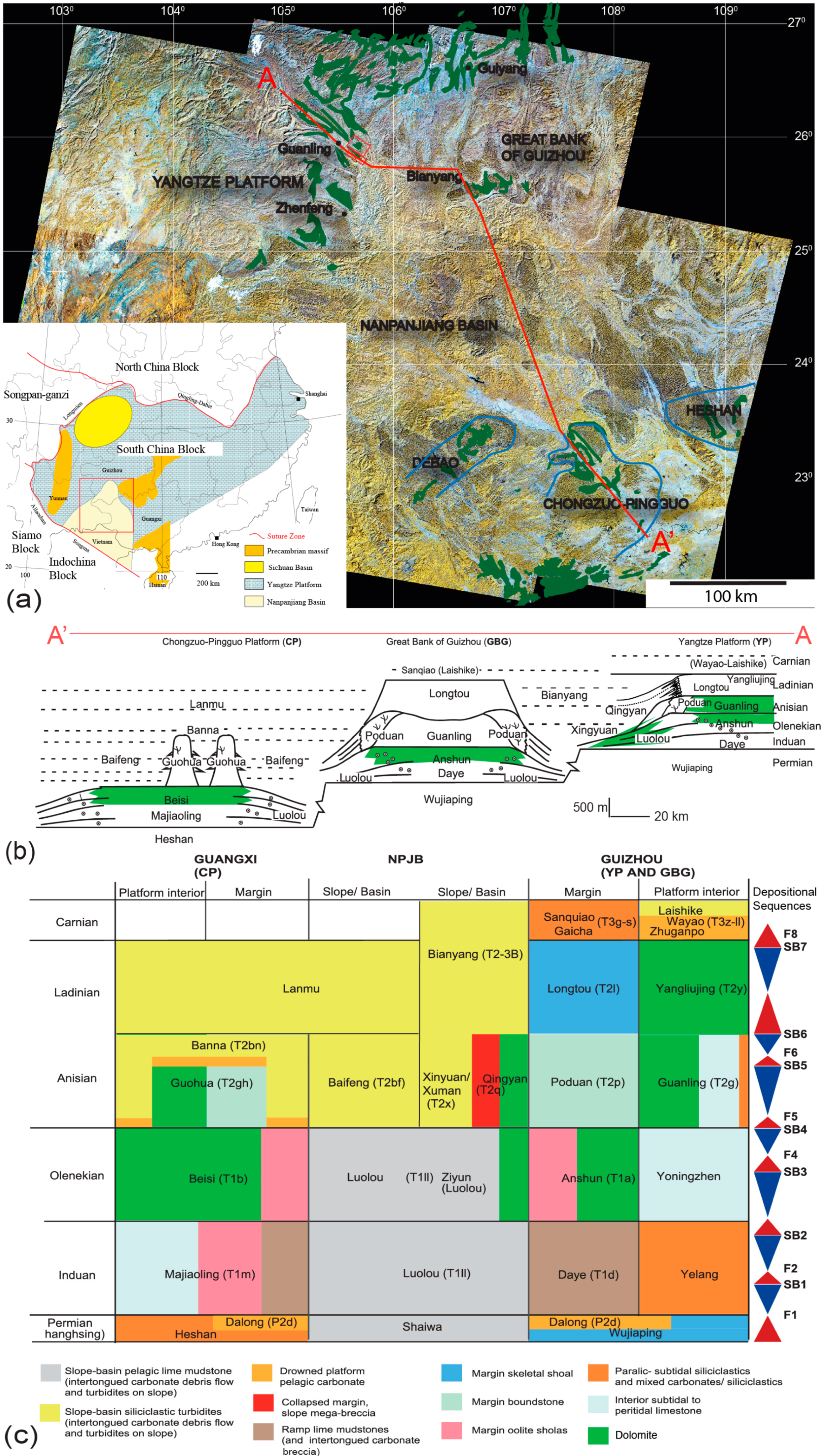
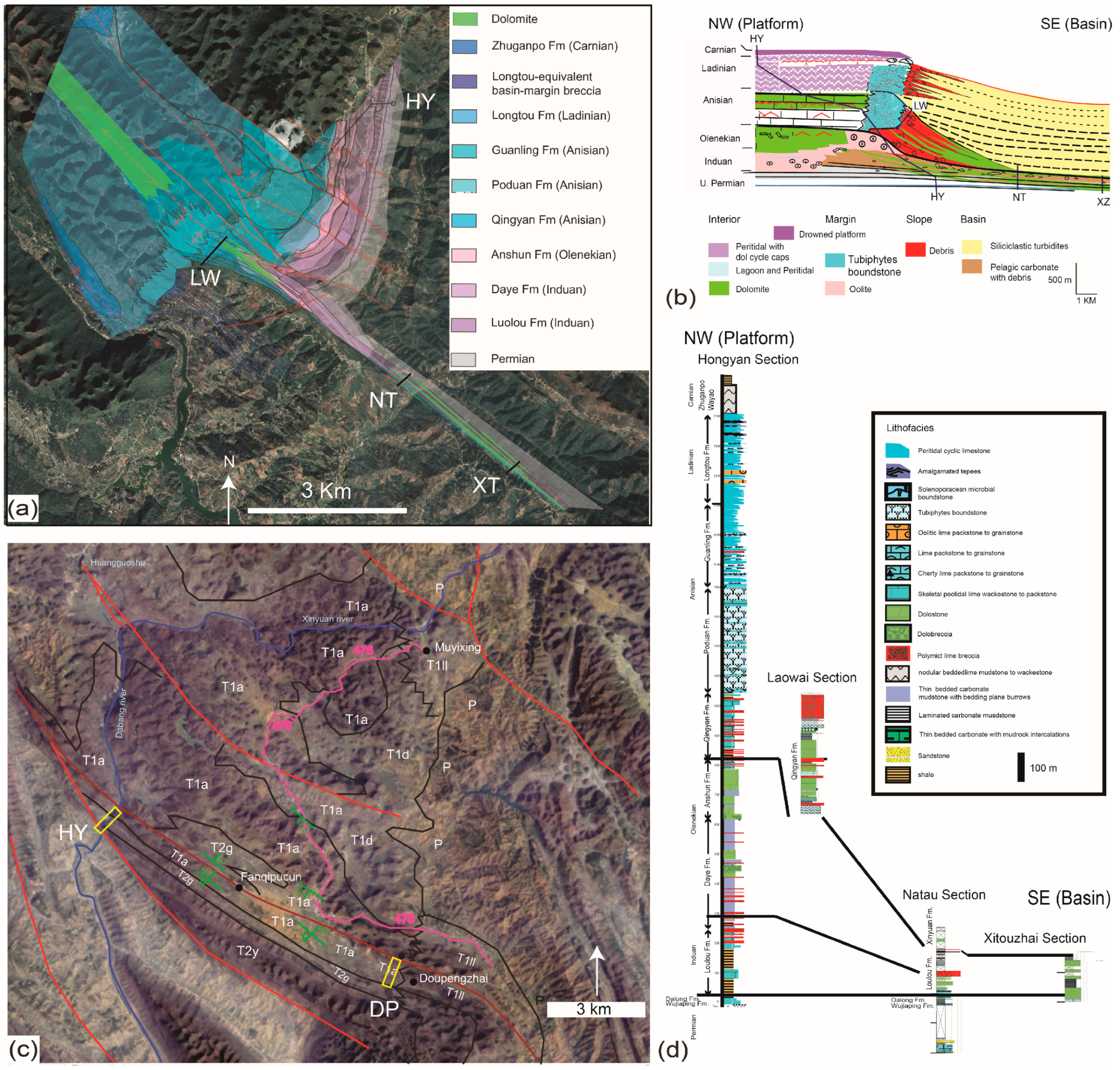
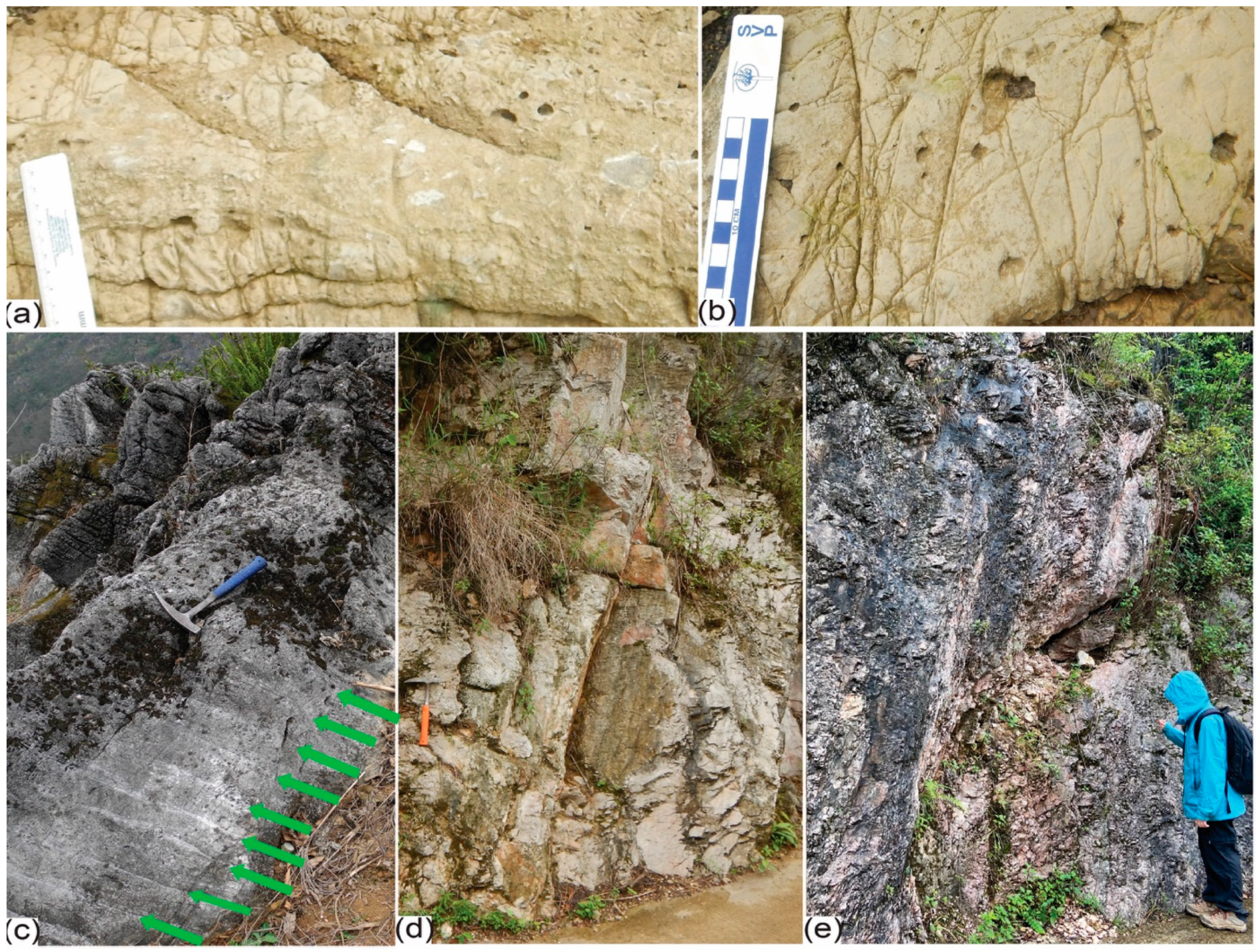
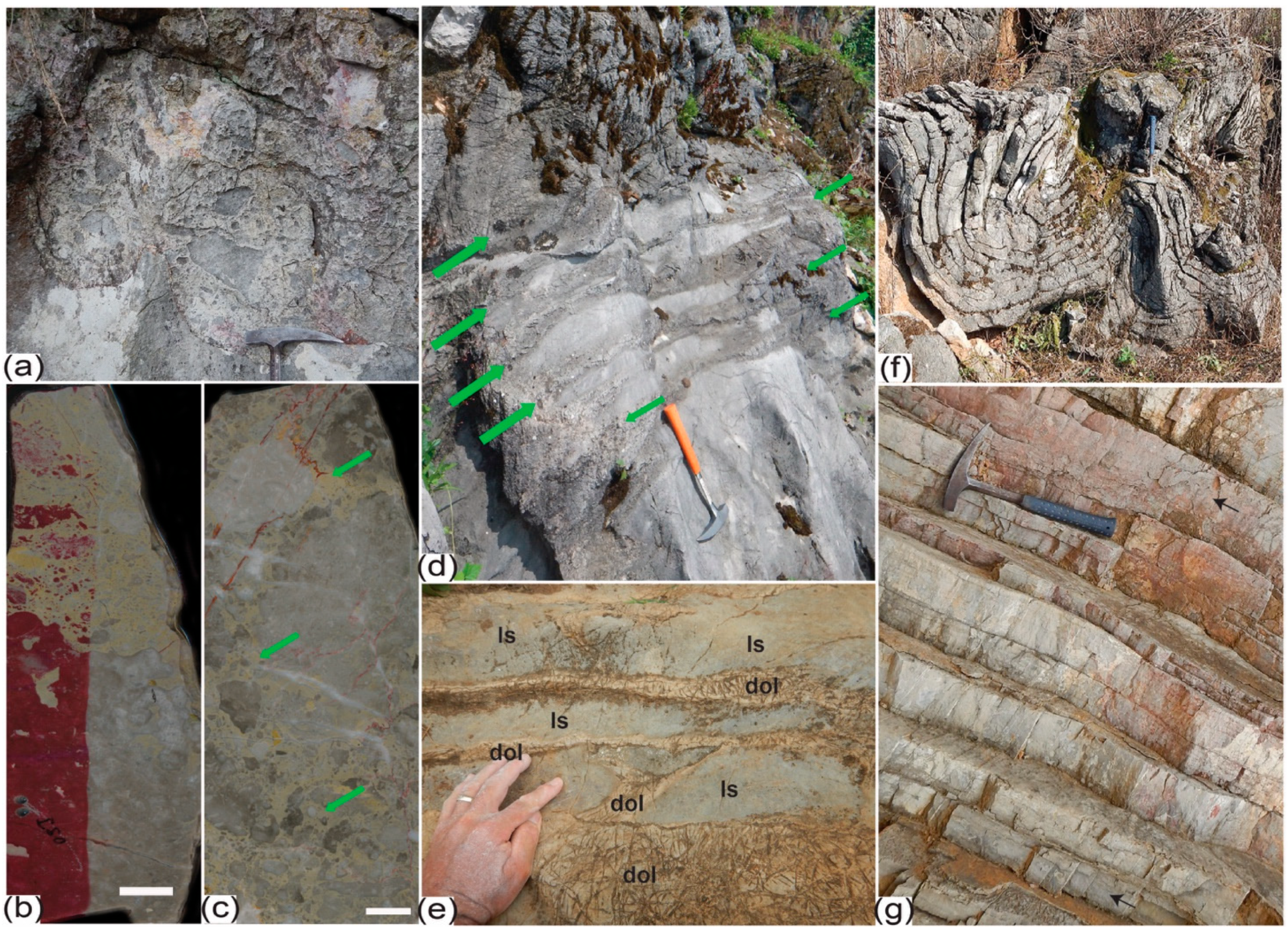
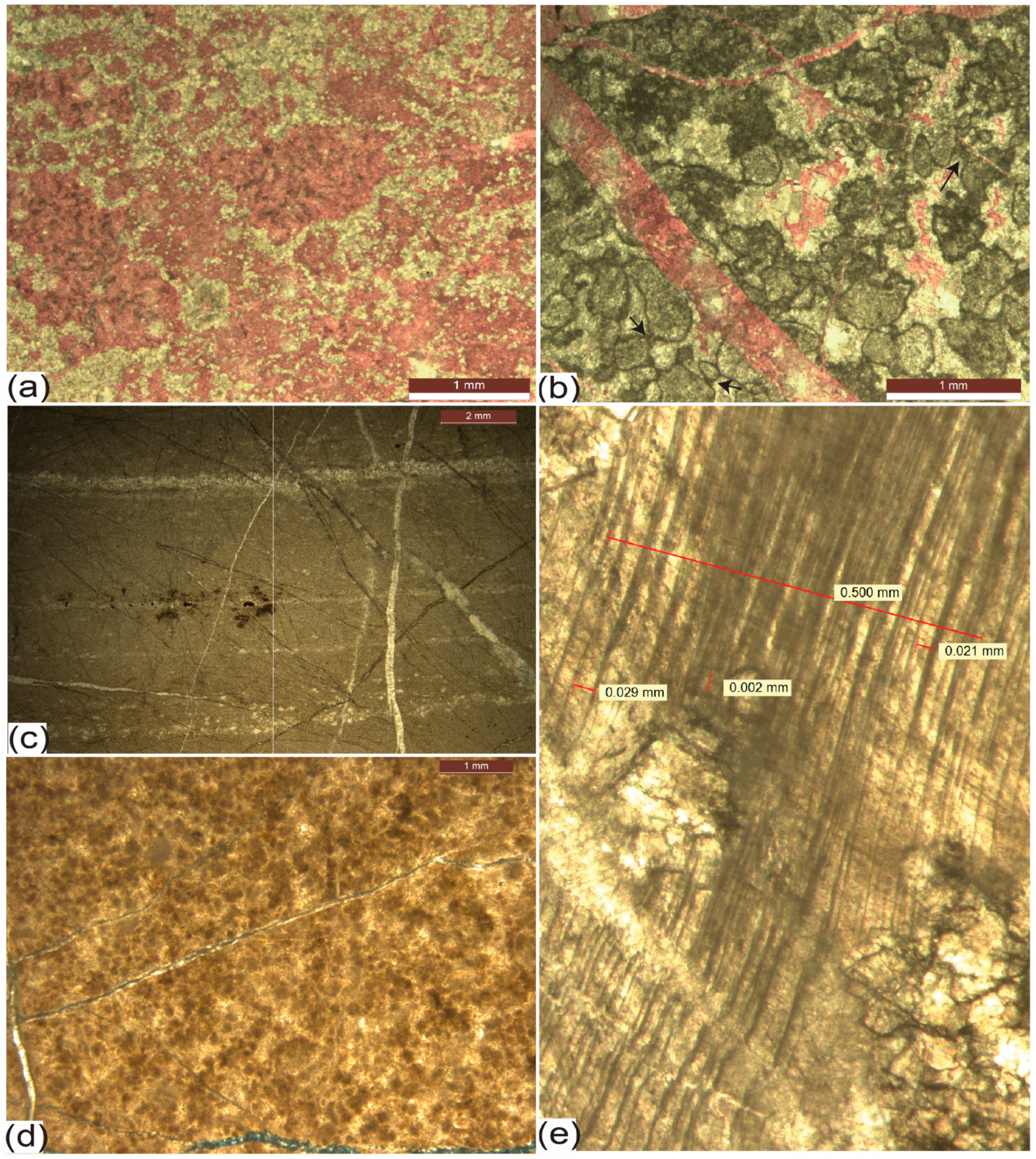
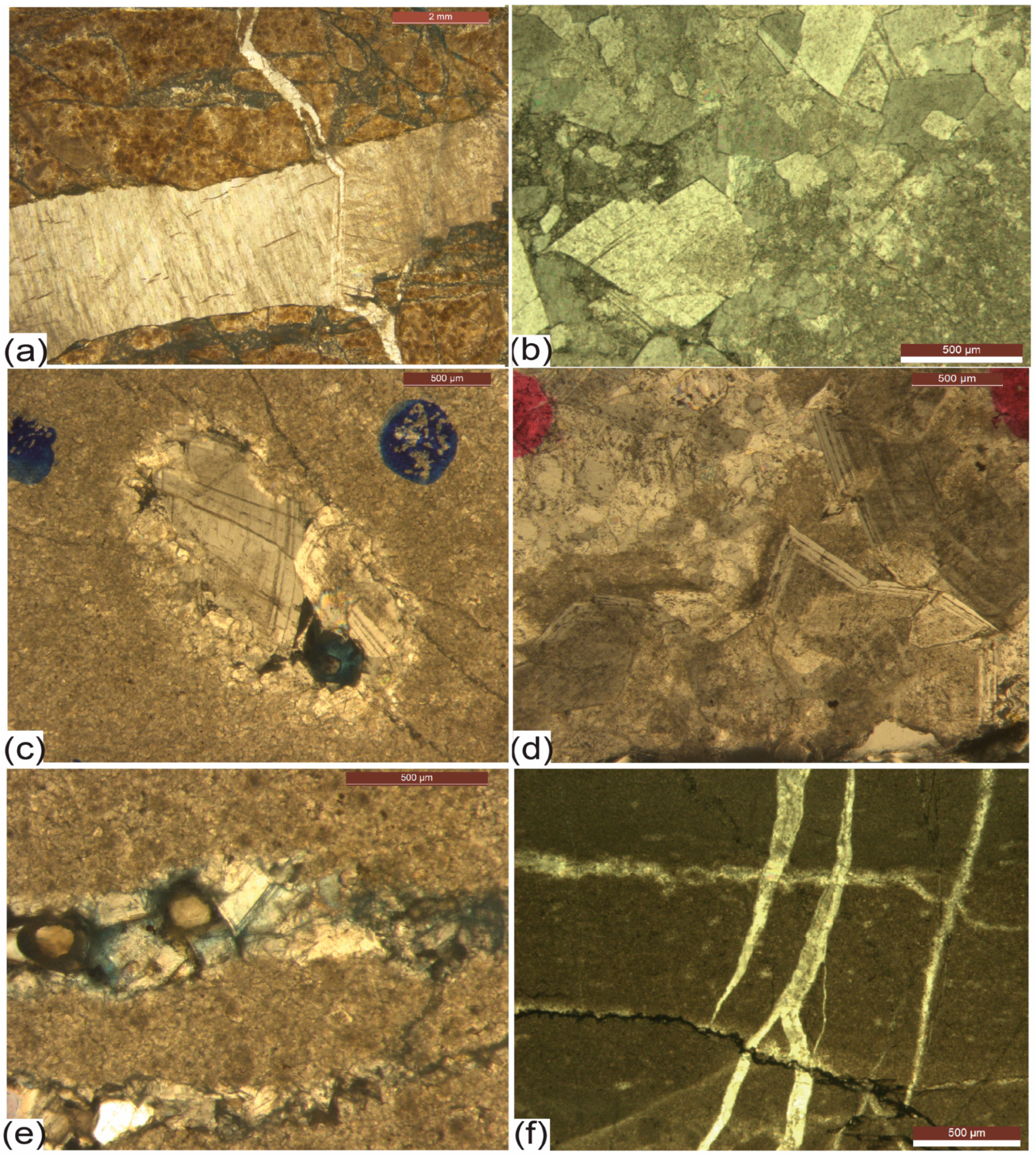
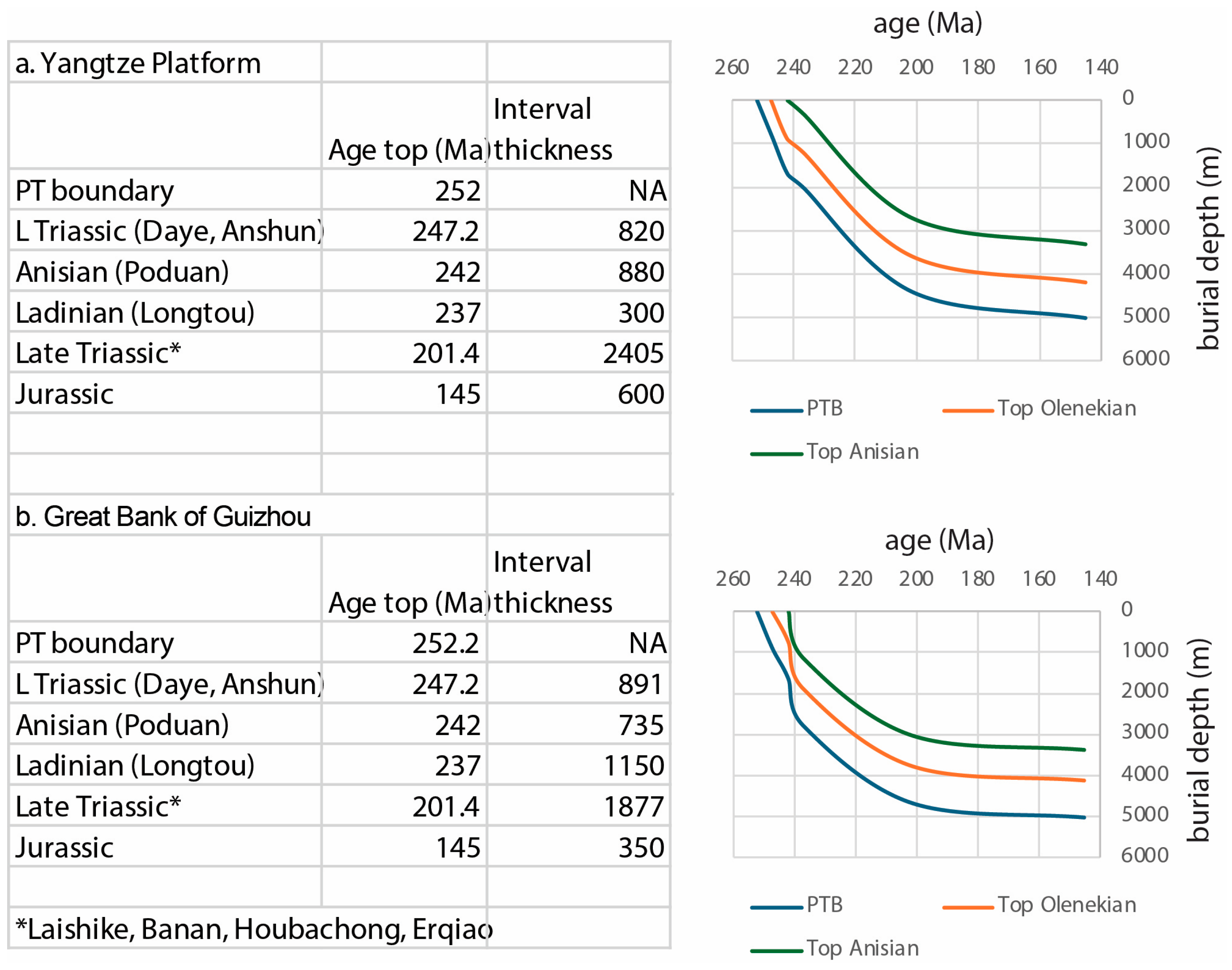
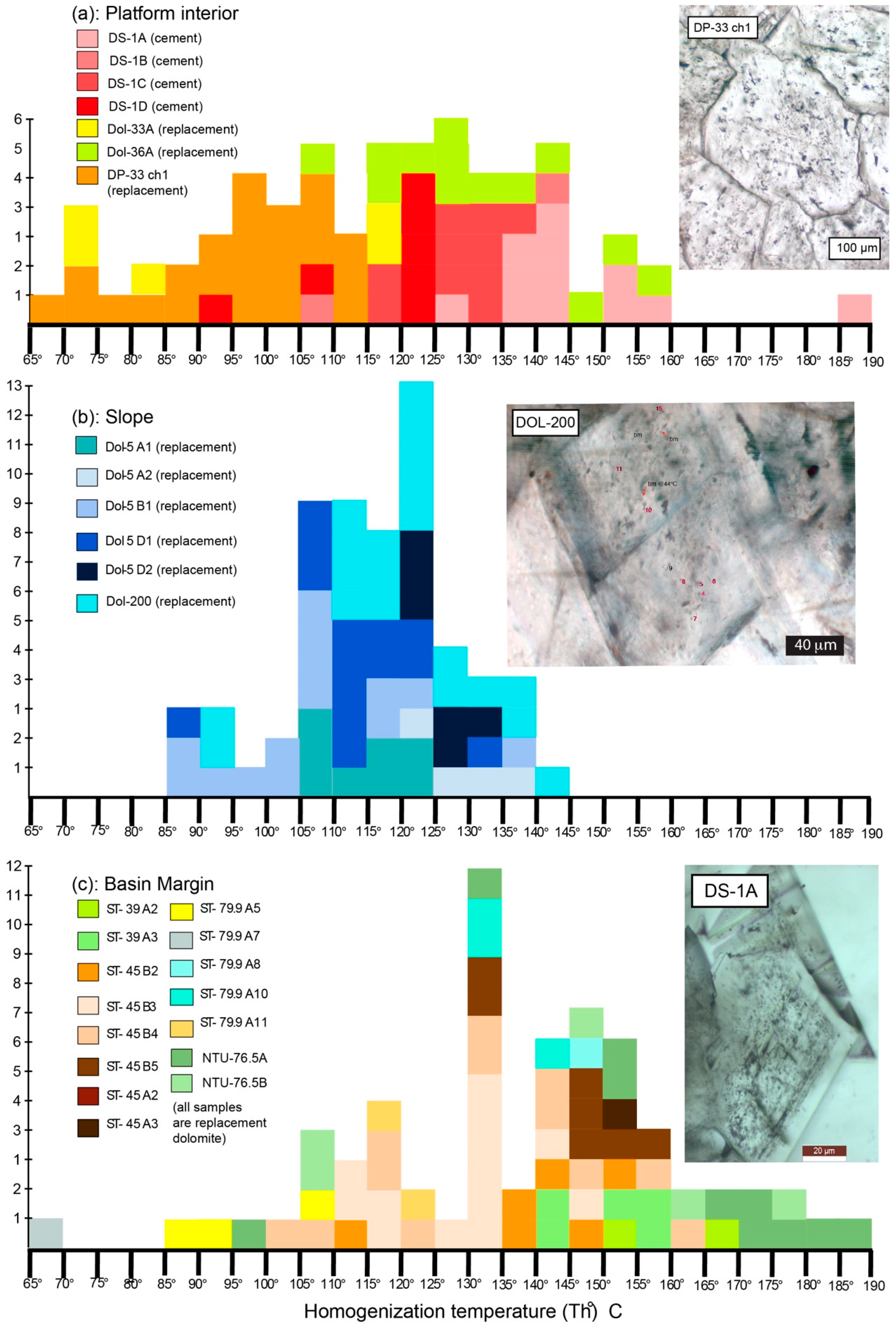
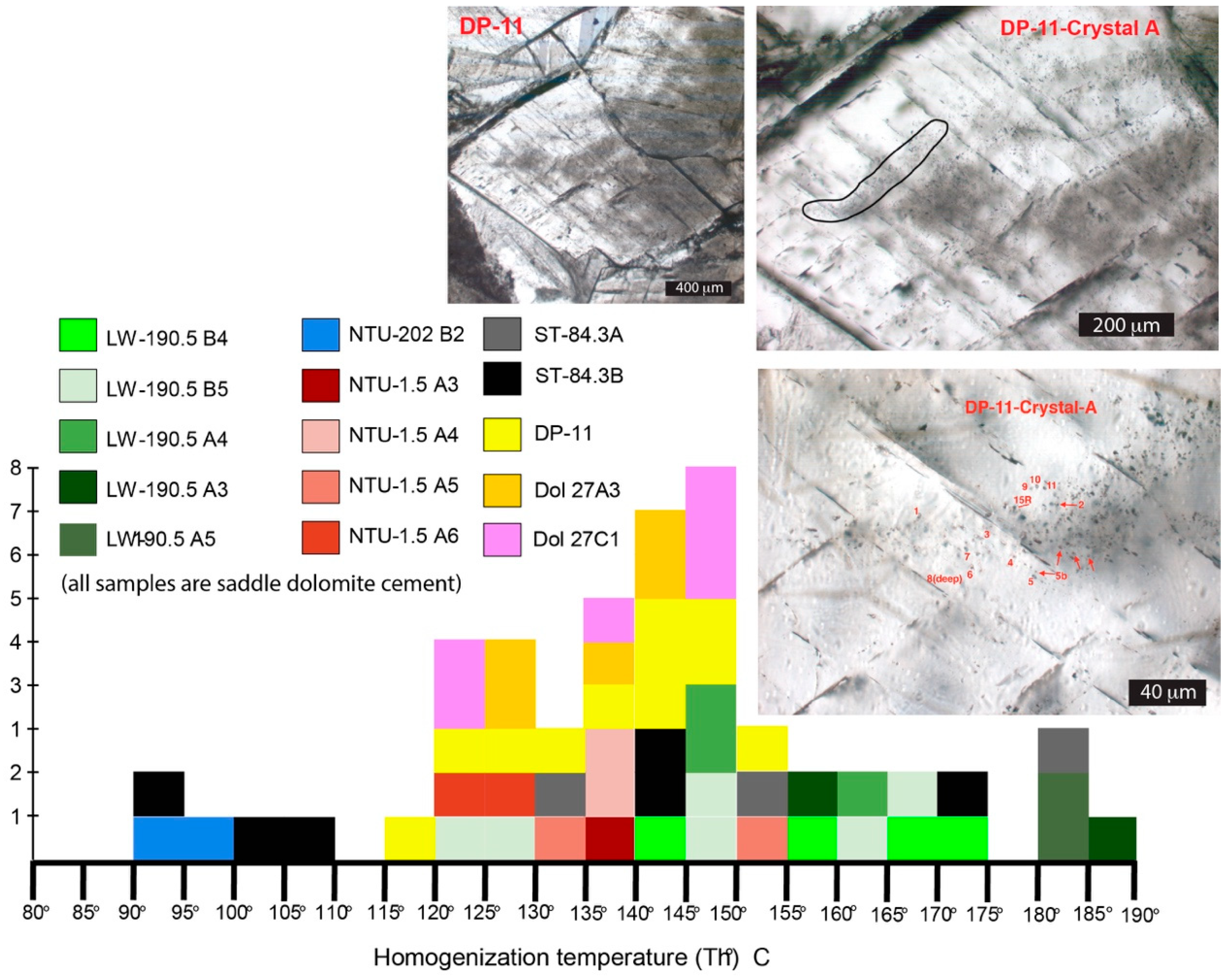
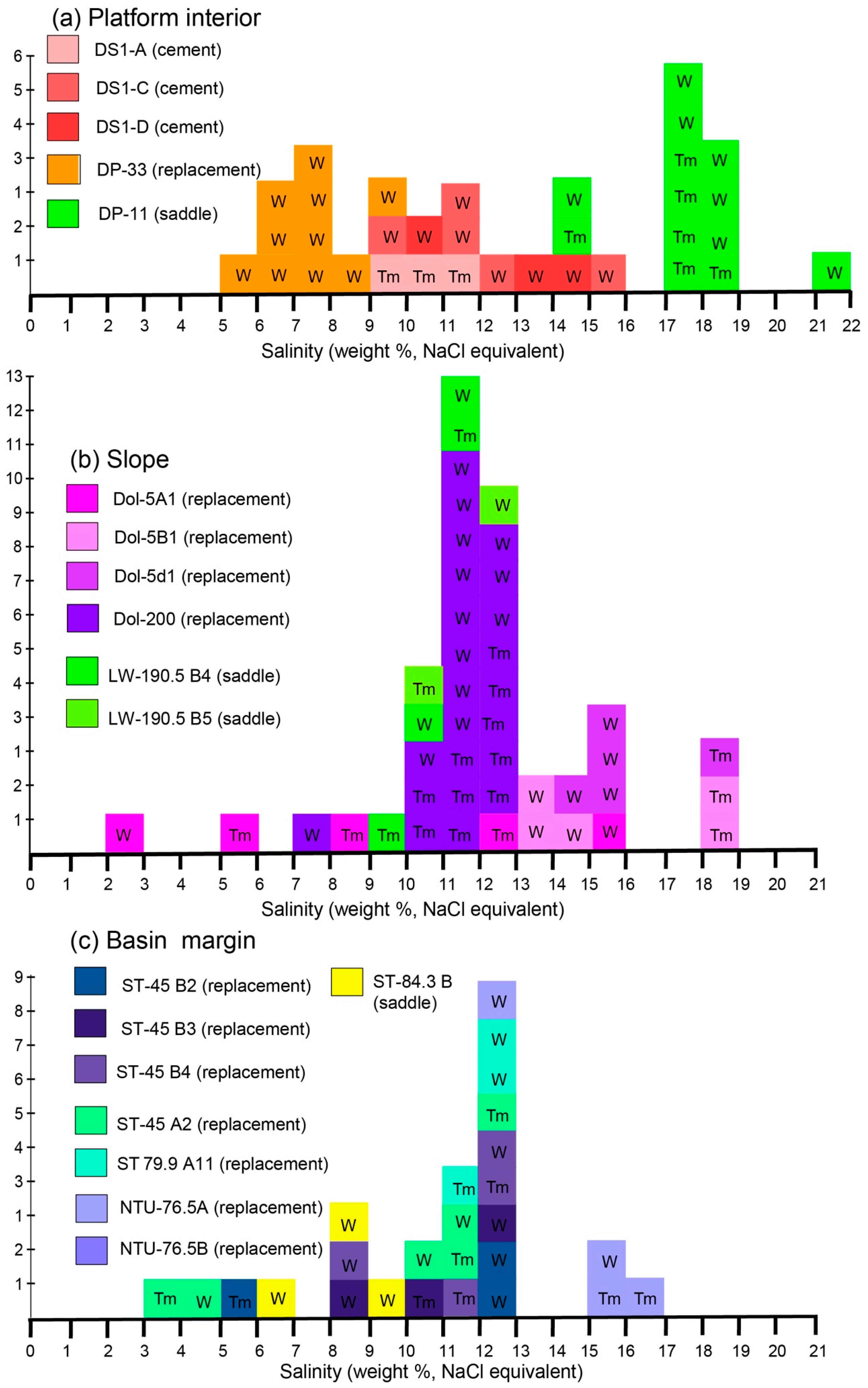


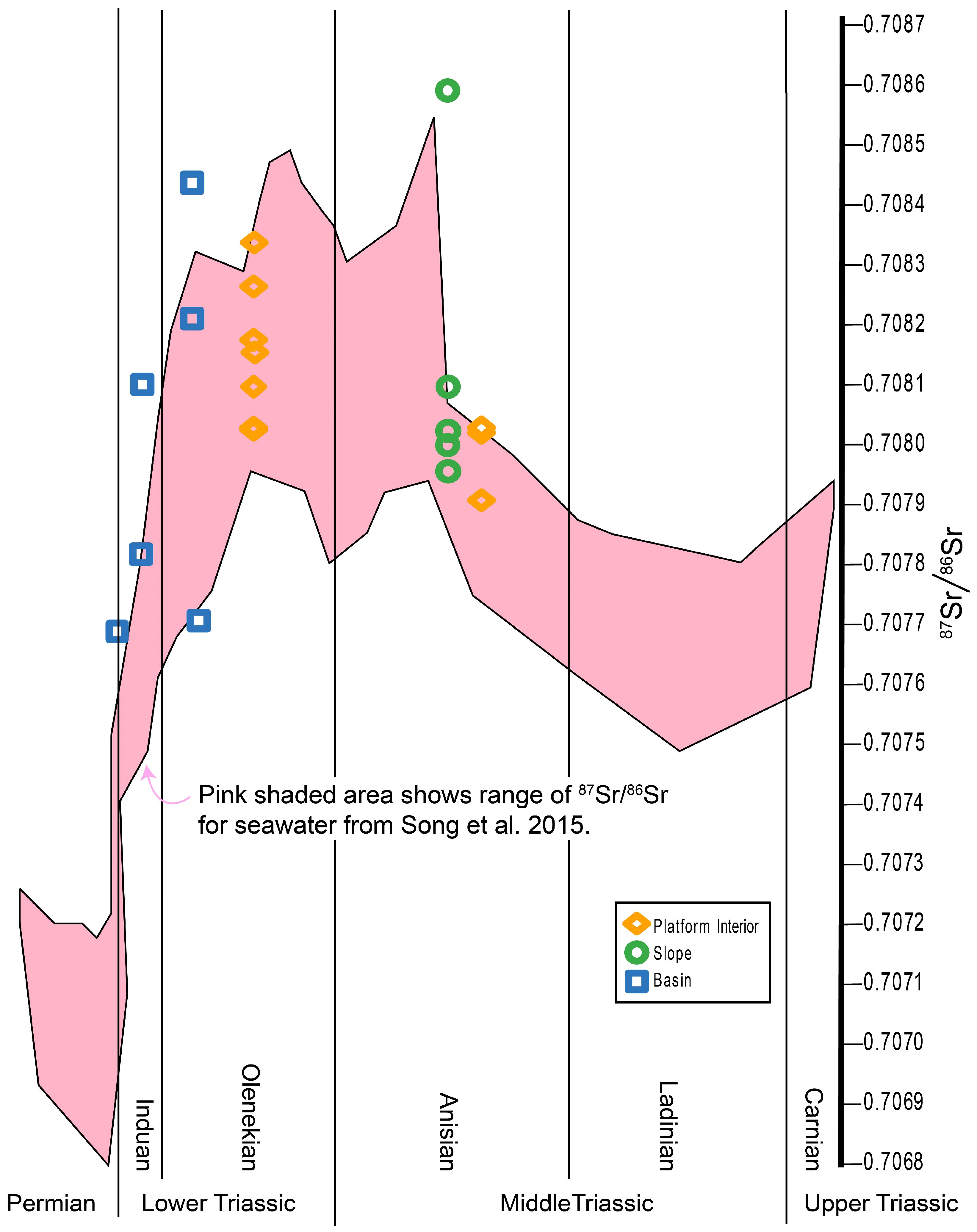
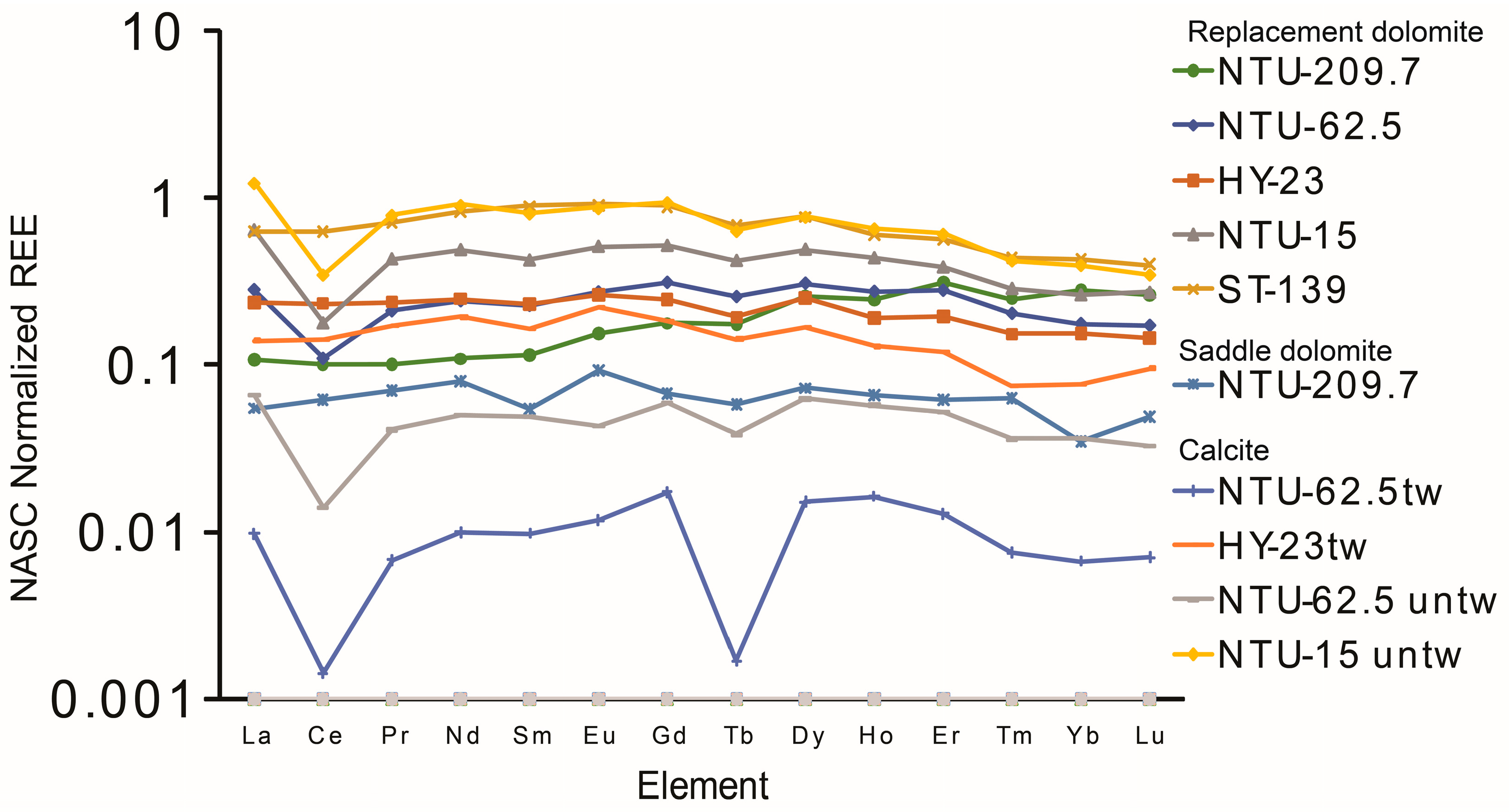
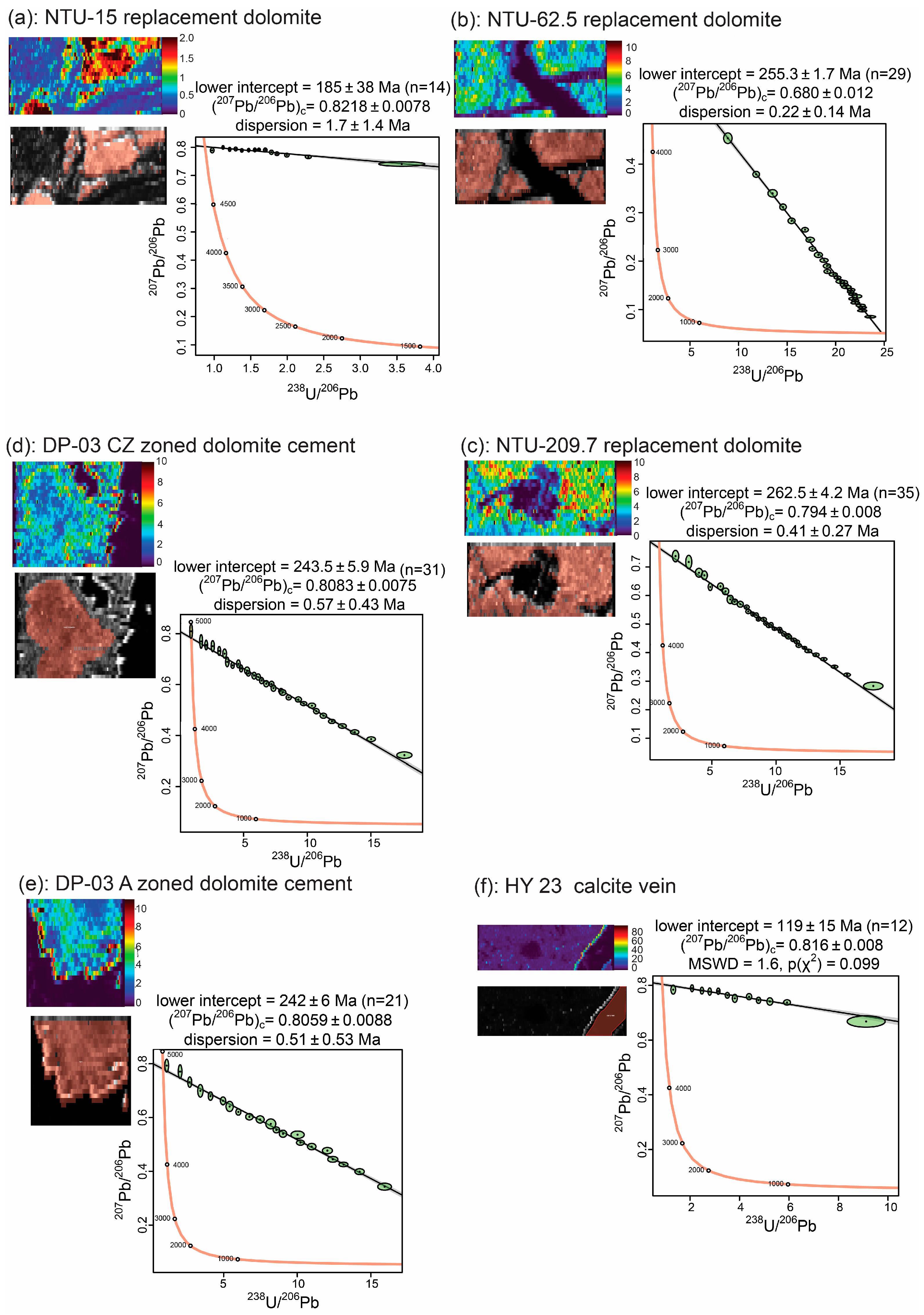
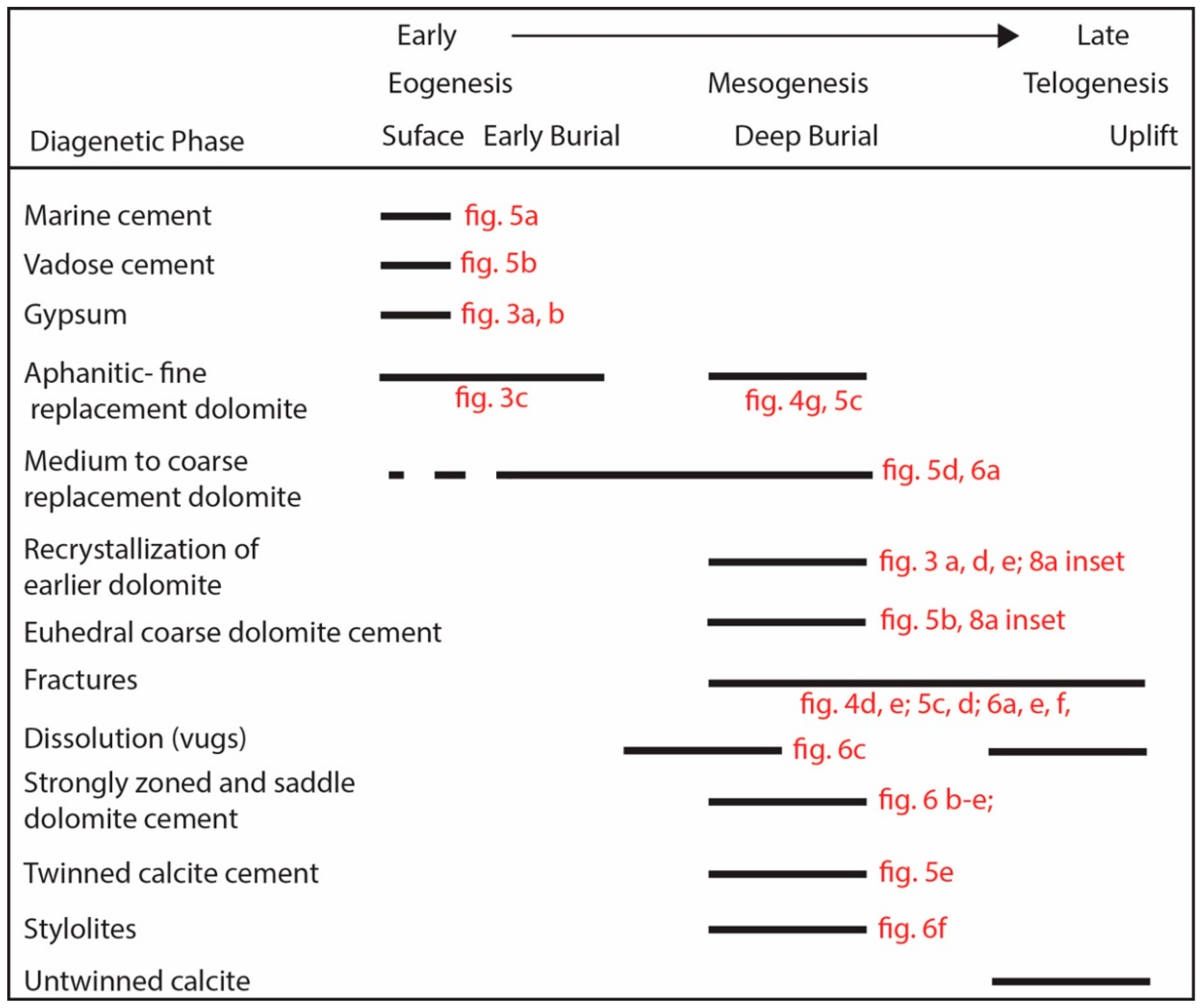
| Age and Stratigraphic Unit | Position on Depositional Profile | Lithofacies | Interpreted Depositional and Diagenetic Environments | Degree of Dolomitization | Dolomite Types and Interpreted Stages of Dolomitization |
|---|---|---|---|---|---|
| Middle Triassic, Anisian | |||||
| Guanling Fm. | Interior | Meter-scale cycles, skeletal oncolitic wk to pk bases, fenestral microbial laminate caps, meniscus cements. | Tidal flats, cycles with subtidal bases, and subaerial exposure on cycle caps. Dolomitization by evaporitic brine on cycle caps *. | Partial; only the subaerially exposed caps of cycles are dolomitized. Fabric preserving. | Syndepositional, replacement anhedral very fine to finely crystalline non-planar. Later coarse crystalline dolomite cement lining fenestral pores. |
| Massive bioturbated skeletal md to wk, stratiform breccias, angular clasts, cauliflower-shaped molds. | Restricted subtidal lagoon, evaporitic conditions, evaporite crystal molds, and bedded evaporites (represented by dissolution collapse breccia). Dolomitization by evaporitic brines *. | Pervasively dolomitized in the Guanling area. Largely fabric destructive. | Replacement anhedral to subhedral, medium to coarsely crystalline with euhedral crystals facing open pores. Later coarse dol. cement and saddle dol. lining vugs and fractures in breccia, cutting across earlier phases. | ||
| Poduan Fm. | Margin | Tubiphytes boundstone, bladed isopachous, and botryoids of cement. | Subtidal marine and extensive marine cement. | Undolomitized except for very minor dolomitization of micritic elements at contact with foreslope. | |
| Qingyan Fm. | Slope | Thin bedded, laminated carbonate mudstone, interbeds of gr, pk, and polymict breccia. | Deep-marine pelagic rain, mass gravity deposits (carbonate turbidites, grain flows, and debris flows). Dolomitization by basin-derived fluids during burial. | Partially dolomitized lime mudstone (fronts cut across beds), micritic matrix in breccias. Largely fabric retentive, locally destructive. | Replacement anhedral to subhedral, medium to coarsely crystalline, and coarsely crystalline dolomite with local euhedral crystals facing open pores in gravity flow deposits. Later coarse crystalline dolomite cement lining pores in gravity flow deposits and vugs in carbonate mudstone. Saddle dolomite lining vugs and fractures that cut across earlier phases of replacement dolomite. |
| Xinyuan Fm. | Basin margin | ||||
| Lower Triassic (Induan-Olenekian) | |||||
| Anshun Fm. (Olenekian) | Interior | Meter-scale cycles, wk to pk bases, fenestral microbial laminate caps; Massive bioturbated skeletal md to wk, stratiform breccias, angular clasts, cauliflower-shaped molds. | Tidal flats and restricted subtidal lagoon. evaporitic conditions, evaporite crystal molds, and bedded evaporites (represented by dissolution collapse breccia). Dolomitization by evaporitic brines of tidal flat and lagoon facies *. | Pervasively dolomitized. Largely fabric destructive. | |
| Gujiao Fm. (Olenekian) | Margin | Oolite grainstone. | Subtidal marine and extensive marine cement | Undolomitized, stratigraphic equiv. of Anshun Fm. dolomitized. | |
| Luolou Fm. (Induan-Olenekian) | Basin margin | Thin bedded, laminated carbonate mudstone, interbeds of gr, pk and polymict breccia. | Deep-marine pelagic rain, mass gravity deposits (carbonate turbidites and debris flows). Dolomitization by basin-derived fluids during burial. | Partially dolomitized lime mudstone (fronts cut across beds), micritic matrix in breccias. Largely fabric retentive, locally destructive. | |
| Upper Permian, Changhsingian | |||||
| Wujiaping Fm. | Basin margin | Skeletal wackestone to packstone. | Shallow-subtidal, open marine (prior to transgressive backstep of margin). Dolomitization by basin-derived fluids during burial. | Pervasively dolomitized locally at the basin margin. Fabric destructive. | |
| Replacement dol | Sr | Th | 238U | 207Pb | Li | B | Fe | Mn | Ce/Ce * |
| Sample | ppm | ppm | ppm | ppm | ppm | ppm | ppm | ppm | |
| HY-23 (coarse) | 478 | 2.31 | 7.49 | 7.69 | 10.01 | 15.83 | 4856 | 604 | 0.94 |
| NTU-15 | 1061 | 0.35 | 0.93 | 2.15 | 1.36 | 5.25 | 883 | 80 | 0.31 |
| NTU-62.5 (coarse) | 268 | 0.2 | 2.85 | 1.31 | 0.97 | 5.8 | 685 | 269 | 0.42 |
| NTU-209.7 (coarse) | 286 | 0.93 | 2.81 | 3.18 | 2.86 | 23.78 | 2839 | 241 | 0.9 |
| ST-139 (fine) | 239 | 7.72 | 2.79 | 17.46 | 11.3 | 84.14 | 6573 | 644 | 0.9 |
| Saddle dol | Sr | Th | U | 207Pb | Li | B | Fe | Mn | Ce/Ce * |
| Sample | ppm | ppm | ppm | ppm | ppm | ppm | ppm | ppm | |
| DP-03 inner zone | 207 | 0.21 | 2.34 | 9.73 | n/a | n/a | n/a | n/a | n/a |
| DP-03 outer zone | 235 | 0.07 | 0.15 | 1.86 | n/a | n/a | n/a | n/a | n/a |
| DP-11 inner zone | 240 | n/a | n/a | n/a | 0.66 | 10.96 | 168 | 143 | 1.02 |
| NTU-209.7 | 407 | 0.05 | 0.12 | 0.59 | 0.67 | 12.79 | 1049 | 217 | 0.92 |
| Calcite | Sr | Th | U | 207Pb | Li | B | Fe | Mn | Ce/Ce * |
| Sample | ppm | ppm | ppm | ppm | ppm | ppm | ppm | ppm | |
| HY-23 | 536 | 0.96 | 0.43 | 0.31 | 0.49 | 3.47 | 618 | 278 | 0.81 |
| NTU-15 | 1565 | 0.5 | 1.79 | 1.94 | 1.57 | 8.05 | 326 | 84 | 0.32 |
| NTU-62.5 (tw) | 352 | 0.09 | 0.72 | 2.33 | 0 | 2.77 | 16 | 77 | 0.16 |
| NTU-62.5 (untw) | 412 | 0.04 | 0.38 | 3.31 | 0 | 2.45 | 70 | 98 | 0.25 |
| Diagenetic History | Interpreted Environments | Supporting Evidence |
|---|---|---|
| 1. Sedimentation | The spectrum of carbonate depositional environments across platform interior to basin margin | See the Geologic Setting Section and precursor carbonate facies in the Petrography Section. |
| 2. Syndepositional cementation | Subtidal marine cement in reef, vadose cement on tidal flats. | Bladed marine cement infill of reef porosity, vadose meniscus micritic cements. |
| 3. Penecontemporaneous dolomite | Subaerially exposed tidal flats, evaporatively concentrated seawater dolomitizes tidal flat surface. | Preferential dolomitization of tidal flat cycle caps in platform interior. |
| 4. Replacement dolomite formed by evaporatively concentrated seawater | Hypersaline lagoon, evaporatively concentrated seawater dolomitizes interior lagoon sediment in situ or via evaporative reflux dolomitization. | Preferential dolomitization of the interior lagoon (not landward or margin facies), association with evaporite crystal molds and evaporite solution collapse breccia, 87Sr/86Sr consistent with seawater source, δ18O consistent with evaporated seawater. |
| 5A. Burial dolomitization (recrystallization of earlier dolomite phases), and associated dolomite cement | High-temperature burial conditions (up to 4.5 km burial, by the end of Triassic). | Fluid inclusion Th (avg. 115 °C, 66–186 °C) containing entrapped brines (avg. 9.7 wt. %, 5.2–15.1 wt. % salinity). Trace elements consistent with reducing conditions. REEs consistent with authigenic carbonate signal reflecting recrystallization in the rock-dominated system. |
| 5B. Replacement dolomite and associated dolomite cement by basin-derived brines at basin margin and slope | High-temperature burial conditions (up to 4.5 km burial, by the end of Triassic), dolomitizing fluids migrate from the basin into the basin margin to foreslope; fluids expelled from compacting basin siliciclastic shale and turbidite units of Xinyuan, Xuman, and Bianyang formations. | Spatial distribution of replacement dolomite from basin margin to slope, fluid inclusion Th (avg. 127 °C, 85–190 °C) containing entrapped brines (avg. 11.7 wt. %, 5–19 wt. % salinity), U-Pb age (Late Triassic-Jurassic) consistent with burial timing. Trace elements consistent with reducing conditions. 87Sr/86Sr and REE signal consistent with the interaction of fluids with basinal siliciclastic facies. |
| 6. Fracturingand dissolution (vugs) | High-temperature burial conditions. | Fractures and vugs petrographically postdate earlier dolomite phases. |
| 7. Saddle dolomite and zoned euhedral dolomite cement precipitation in fractures, vugs and intergranular porosity. | High-temperature burial conditions (up to 3.6 to 5 km burial by end of Jurassic). | Saddle dolomite is considered a high temp phase [79], fluid inclusion Th (avg. 141 °C, range of 90–185 °C) containing entrapped brines (avg. 14.1 wt. %, 6.9–19 wt. % salinity). |
| 8. Additional generations of fractures, calcite vein fill of fractures | High-temperature burial conditions. | Calcite-filled fractures petrographically postdate all the dolomite phases. U-Pb age date indicates Cretaceous age. |
| 9. Development of deformation twinning in calcite | High-temperature burial conditions. | Calcite twins of type 1 (thin twins, >40 twins/mm) indicate deformation at temperatures up to 170 °C [64] deformation consistent with regional deformation. |
| 10. Stylolitization | High-temperature burial conditions. | Petrographically postdate dolomite and twinned calcite phases. |
Disclaimer/Publisher’s Note: The statements, opinions and data contained in all publications are solely those of the individual author(s) and contributor(s) and not of MDPI and/or the editor(s). MDPI and/or the editor(s) disclaim responsibility for any injury to people or property resulting from any ideas, methods, instructions or products referred to in the content. |
© 2025 by the authors. Licensee MDPI, Basel, Switzerland. This article is an open access article distributed under the terms and conditions of the Creative Commons Attribution (CC BY) license (https://creativecommons.org/licenses/by/4.0/).
Share and Cite
Ledbetter Ferrill, N.S.; Li, X.; Tesauro, J.; Sears, M.; Bradley, G.M.; Hilbert, A.; Carney, E.; Saxby, J.; Mobasher, N.; Kelley, B.M.; et al. Massive Dolomitization of Interior and Slope to Basin-Margin Facies of the Triassic Yangtze Platform Through Superposed Earth-Surface and Burial Mechanisms, Nanpanjiang Basin, South China. Minerals 2025, 15, 324. https://doi.org/10.3390/min15030324
Ledbetter Ferrill NS, Li X, Tesauro J, Sears M, Bradley GM, Hilbert A, Carney E, Saxby J, Mobasher N, Kelley BM, et al. Massive Dolomitization of Interior and Slope to Basin-Margin Facies of the Triassic Yangtze Platform Through Superposed Earth-Surface and Burial Mechanisms, Nanpanjiang Basin, South China. Minerals. 2025; 15(3):324. https://doi.org/10.3390/min15030324
Chicago/Turabian StyleLedbetter Ferrill, Nathaniel S., Xiaowei Li, Josephine Tesauro, Madison Sears, George M. Bradley, Arianna Hilbert, Eryn Carney, Justice Saxby, Neda Mobasher, Brian M. Kelley, and et al. 2025. "Massive Dolomitization of Interior and Slope to Basin-Margin Facies of the Triassic Yangtze Platform Through Superposed Earth-Surface and Burial Mechanisms, Nanpanjiang Basin, South China" Minerals 15, no. 3: 324. https://doi.org/10.3390/min15030324
APA StyleLedbetter Ferrill, N. S., Li, X., Tesauro, J., Sears, M., Bradley, G. M., Hilbert, A., Carney, E., Saxby, J., Mobasher, N., Kelley, B. M., Rasbury, E. T., Wooton, K. M., Kirk, J. D., Luczaj, J. A., & Lehrmann, D. J. (2025). Massive Dolomitization of Interior and Slope to Basin-Margin Facies of the Triassic Yangtze Platform Through Superposed Earth-Surface and Burial Mechanisms, Nanpanjiang Basin, South China. Minerals, 15(3), 324. https://doi.org/10.3390/min15030324





